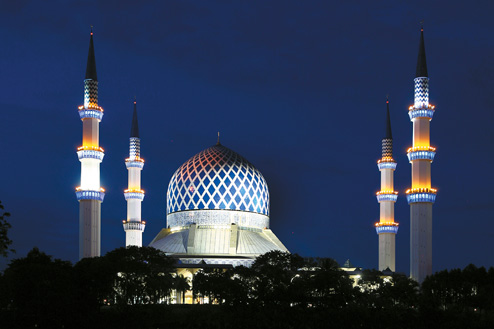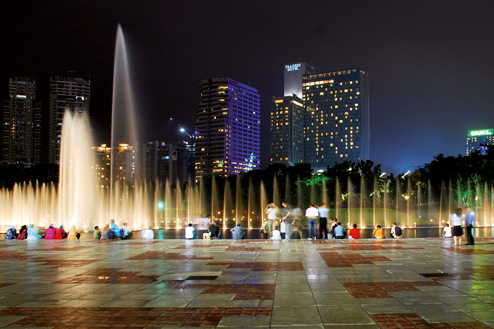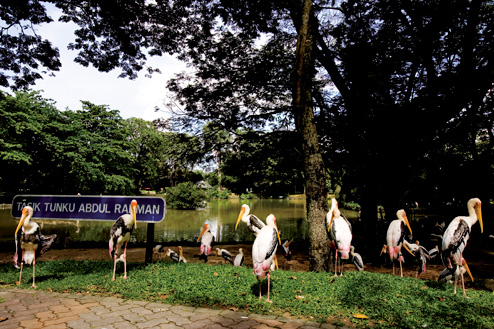Petaling Jaya
The establishment of Petaling Jaya, and later other suburbs, was initially intended to resolve the problem of overcrowding in KL. There was a need to resettle urban squatters located on inner city land that was earmarked for development. The Selangor State Government acquired almost 500 hectares of poor quality rubber estate in 1951 in what is now PJ.
Older residents refer to the Old and New Town sections of central Petaling Jaya. The Old Town is located near the intersection of Jalans Selangor, Othman and Pasar (east of Assunta Hospital). There is a large wet and dry market here and some good hawker stall food.
The New Town is the civic centre located in what the locals call PJ State because of the cinema here near the large council office block named Menara MPPJ.
There are green spaces in Petaling Jaya, with Bukit Gasing Forest Reserve (Gasing Hill) holding out against developers who would love to carve it up and develop more towering condominium blocks similar to those that already line the periphery. There are various walking trails through the secondary forest here and organisations like the Hash House Harriers are known to run along these. Access points are located around the edges and there are some reasonable views of KL and PJ from the highest point. The best access is from Jalan Lembah 5/4, which runs off Jalan Gasing near the ornate Poh Lum Fatt Yuen Chinese Temple. The reserve is home to wildlife including birds, snakes, monitor lizards, monkeys and squirrels. There is an entrance to the park at Jalan Telok, one kilometre up the hill from the temple.
Siva Temple is on the summit of Bukit Gasing and there are some decent elevated views across Petaling Jaya. The hill lies in both PJ and KL territory and town planning policies appear to be different, with KL being more proactive in seeing the hill ‘developed’. The temple is reached by turning off Jalan Gasing into Jalan 5/64 which leads to Jalan 5/66A – just head for the Telecom Tower and look for the monkeys playing in the trees. There is another temple (Sri Maha Kaliamman) nearby but this has little tourism interest.
The other main recreation area in Petaling Jaya is Taman Jaya, bordered by the Federal Highway and Jalans Gasing and Timur. There is a large lake that is popular with local anglers, as well as walking paths, large grassy areas and car parks. The park is reasonably well maintained and is popular at sunrise and dusk.
There is a Hindu temple in one corner and nearby, on Jalan Pantai 9/7, there is a church, a Chinese temple and a Thai Buddhist temple. The glittering Thai Chetawan Buddhist Temple is a magnificent example of classical Thai architecture; a sight not commonly seen in Malaysia. Covered in gold, it is a dominant feature of the PJ landscape. It was officially opened in 1962 by the current king of Thailand, King Bhumibol. Being a Buddhist temple, visitors need to remove their shoes before entering. Vesak or Wesak Day, held in May, is a good time to visit so you can join in the celebrations associated with Buddha’s birth, death and enlightenment.
Petaling Jaya and the state of Selangor begins along the Federal Highway with a ceremonial archway (Kota Darul Ehsan) located just after the turn off to Bangsar. Universiti of Malaya is on the northern side of the road. The archway sprawls across the highway and marks the boundary between the Federal Capital (KL) and Selangor state. It is not advisable to stop here (it’s actually illegal unless your vehicle has broken down) so simply drive underneath and admire it; keep your passport in your pocket as it is not required.
The distinction between KL and PJ is not obvious, especially in the location of Universiti Malaya and the adjoining Universiti Hospital both of which are actually in KL but could easily be mistaken for PJ. There are several entrances to the university, Malaysia’s first institute of higher learning. The main entrances are along Jalans Pantai Baharu (eastern side) and Jalan Universiti (western side). While access is normally restricted to vehicles displaying official stickers, security guards will allow visitors to enter two places of interest – Rimba Ilmu (‘Forest of Learning’ botanical gardens) and the Muzium Seni Asia (Museum of Asian Arts).
There is basically a one way circular road system around the expansive and landscaped university grounds. Look for the signs to Rimba Ilmu, which occupies 80 hectares of the campus near the squash complex and sports field. The entry gate and visitor registration area are located in the Institute of Biological Sciences, a distance past the dormitories called Rumah Universiti. Rimba Ilmu is open Monday to Friday from 09:00 to 16:00, and the first Saturday of the month from 09:00 to 12:00. An exhibition has been established in the registration area, as has a superbly labelled garden trail leading into the gardens themselves. The gardens are divided into wetlands, palms, mixed forest species, fruit trees and medicinal plants. There are many tropical plants growing in a near natural setting, and the gardens remain one of KL’s best kept secrets.
The Museum of Asian Arts (7967 3805, www.um.edu.my) is located near the Faculty of Economics and Administration off Jalan Ilmu Baru; this is best accessed via the western entrance (the unmarked entrance to the car park is the first turn to the left after the Faculty of Economics, just 100 metres from the Jalan Universiti or western entrance). The building has a large sign but this is not clear until after you have driven past it. Wahid’s Food Court is at the front entrance.
The small but representative collection, spread over three floors, includes local cultural items and Chinese and south Asian ceramics. It supposedly has the world’s largest collection of kendi (ceramic water vessels), and the keris (Malaysian dagger) collection is also impressive. The collection of Ban Chiang pottery from Thailand is good and there are some detailed songket textile weavings. The museum is open during office hours from Monday to Friday and on Saturday mornings. There is also a good collection of films, slides and pictures for research purposes and the staff are very helpful.
Older residents refer to the Old and New Town sections of central Petaling Jaya. The Old Town is located near the intersection of Jalans Selangor, Othman and Pasar (east of Assunta Hospital). There is a large wet and dry market here and some good hawker stall food.
The New Town is the civic centre located in what the locals call PJ State because of the cinema here near the large council office block named Menara MPPJ.
There are green spaces in Petaling Jaya, with Bukit Gasing Forest Reserve (Gasing Hill) holding out against developers who would love to carve it up and develop more towering condominium blocks similar to those that already line the periphery. There are various walking trails through the secondary forest here and organisations like the Hash House Harriers are known to run along these. Access points are located around the edges and there are some reasonable views of KL and PJ from the highest point. The best access is from Jalan Lembah 5/4, which runs off Jalan Gasing near the ornate Poh Lum Fatt Yuen Chinese Temple. The reserve is home to wildlife including birds, snakes, monitor lizards, monkeys and squirrels. There is an entrance to the park at Jalan Telok, one kilometre up the hill from the temple.
Siva Temple is on the summit of Bukit Gasing and there are some decent elevated views across Petaling Jaya. The hill lies in both PJ and KL territory and town planning policies appear to be different, with KL being more proactive in seeing the hill ‘developed’. The temple is reached by turning off Jalan Gasing into Jalan 5/64 which leads to Jalan 5/66A – just head for the Telecom Tower and look for the monkeys playing in the trees. There is another temple (Sri Maha Kaliamman) nearby but this has little tourism interest.
The other main recreation area in Petaling Jaya is Taman Jaya, bordered by the Federal Highway and Jalans Gasing and Timur. There is a large lake that is popular with local anglers, as well as walking paths, large grassy areas and car parks. The park is reasonably well maintained and is popular at sunrise and dusk.
There is a Hindu temple in one corner and nearby, on Jalan Pantai 9/7, there is a church, a Chinese temple and a Thai Buddhist temple. The glittering Thai Chetawan Buddhist Temple is a magnificent example of classical Thai architecture; a sight not commonly seen in Malaysia. Covered in gold, it is a dominant feature of the PJ landscape. It was officially opened in 1962 by the current king of Thailand, King Bhumibol. Being a Buddhist temple, visitors need to remove their shoes before entering. Vesak or Wesak Day, held in May, is a good time to visit so you can join in the celebrations associated with Buddha’s birth, death and enlightenment.
Petaling Jaya and the state of Selangor begins along the Federal Highway with a ceremonial archway (Kota Darul Ehsan) located just after the turn off to Bangsar. Universiti of Malaya is on the northern side of the road. The archway sprawls across the highway and marks the boundary between the Federal Capital (KL) and Selangor state. It is not advisable to stop here (it’s actually illegal unless your vehicle has broken down) so simply drive underneath and admire it; keep your passport in your pocket as it is not required.
The distinction between KL and PJ is not obvious, especially in the location of Universiti Malaya and the adjoining Universiti Hospital both of which are actually in KL but could easily be mistaken for PJ. There are several entrances to the university, Malaysia’s first institute of higher learning. The main entrances are along Jalans Pantai Baharu (eastern side) and Jalan Universiti (western side). While access is normally restricted to vehicles displaying official stickers, security guards will allow visitors to enter two places of interest – Rimba Ilmu (‘Forest of Learning’ botanical gardens) and the Muzium Seni Asia (Museum of Asian Arts).
There is basically a one way circular road system around the expansive and landscaped university grounds. Look for the signs to Rimba Ilmu, which occupies 80 hectares of the campus near the squash complex and sports field. The entry gate and visitor registration area are located in the Institute of Biological Sciences, a distance past the dormitories called Rumah Universiti. Rimba Ilmu is open Monday to Friday from 09:00 to 16:00, and the first Saturday of the month from 09:00 to 12:00. An exhibition has been established in the registration area, as has a superbly labelled garden trail leading into the gardens themselves. The gardens are divided into wetlands, palms, mixed forest species, fruit trees and medicinal plants. There are many tropical plants growing in a near natural setting, and the gardens remain one of KL’s best kept secrets.
The Museum of Asian Arts (7967 3805, www.um.edu.my) is located near the Faculty of Economics and Administration off Jalan Ilmu Baru; this is best accessed via the western entrance (the unmarked entrance to the car park is the first turn to the left after the Faculty of Economics, just 100 metres from the Jalan Universiti or western entrance). The building has a large sign but this is not clear until after you have driven past it. Wahid’s Food Court is at the front entrance.
The small but representative collection, spread over three floors, includes local cultural items and Chinese and south Asian ceramics. It supposedly has the world’s largest collection of kendi (ceramic water vessels), and the keris (Malaysian dagger) collection is also impressive. The collection of Ban Chiang pottery from Thailand is good and there are some detailed songket textile weavings. The museum is open during office hours from Monday to Friday and on Saturday mornings. There is also a good collection of films, slides and pictures for research purposes and the staff are very helpful.













